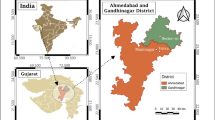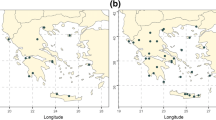Abstract
The present paper discusses the effectiveness of advanced modeling tools as a means of forecasting daily PM10 values, presenting as a case study the Greater Athens Area. The effectiveness of the described approaches is judged against mature forecasting approaches (e.g. linear regression and neural networks) in terms of absolute prediction error metrics and the confusion matrix, which shows the ability to correctly predict exceedances of the regulatory limit. Finally, a new approach is presented that incorporates the short-term dynamics of the PM10 time series into the forecasting model as explanatory variable.
Preview
Unable to display preview. Download preview PDF.
Similar content being viewed by others
References
Chaloulakou A, Grivas G, Spyrellis N, Neural network and multiple regression models for PM10 prediction in Athens. A comparative assessment. J. Air & Waste Man. Assoc. 53 : 1183–1190.
Corani G. (2005) Air quality prediction in Milan: Feed-forward neural networks, pruned neural networks and lazy learning. Ecolog. Mod. 185 (2-4):513-529.
Farmer JD, Sidorowich JJ. (1988) Predicting chaotic dynamics, Dynamic patterns in complex systems, In: J. A. S. Kelso, A. J. Mandell and M. F. Shlesinger (Eds.), World Scientific, pp 265-292.
Gardner M.W. (1999). The advantages of artificial neural network and regression tree based air quality models. Ph.D. Thesis, University of East Anglia, UK.
Hagan M, Menhaj M. (1996) Training feed-forward networks with the Marquardt algorithm, IEEE Tr. on Neural Networks 5 : 989-993.
Hooyberghs J, Mensink C, Dumont G, Fierens F, Brasseur O. (2005) A neural network forecast for daily average PM10 concentrations in Belgium. Atmos. Environ. 39 (18) : 3279-3289.
Katsouyanni K. (2003) Ambient air pollution and health. British Med. Bull. 68: 143-156.
Kukkonen J, Partanen L et al. (2003) Extensive evaluation of neural extensive evaluation of neural network models for the prediction of NO2 and PM10 concentrations, compared with a deterministic modeling system and measurements in central Helsinki. Atmos. Environ. 37: 4539–4550.
McKendry I. (2000) Evaluation of Artificial Neural Networks for Fine Particulate Pollution (PM10 and PM2 .5) Forecasting. J. Air & Waste Man. Assoc., 52 : 1096-1101.
Ordieres JB, Vergara EP, Capuz RS, Salazar RE. (2005). Neural network prediction model for fine particulate matter (PM 2.5) on the US-Mexico border in El Paso (Texas) and Ciudad Juαrez (Chihuahua), Environ. Model. Soft. 20(5) : 547-559.
Perez P, Trier A, Reyes J. (2000) Prediction of PM2.5 concentrations several hours in advance using neural networks in Santiago, Chile. Atmos. Environ. 34 : 1189-1196.
Samoli E, Analitis A, Touloumi G et al. (2001) Estimating the exposure-response relationships between particulate matter and mortality within the APHEA multicity project. Environ. Health. Perspect. 12 : 521–531.
Vlachogiannis D, Sfetsos A. (2006). Time series forecasting of hourly PM10 values: model intercomparison and the development of localized linear approaches. Air Pollution XIV, edited by Longhurst, J. W. S. and Brebbia, C. A., WIT Press, pp. 85- 94.
Acknowledgements
The authors acknowledge partial funding for the presented work by the EU project “PERL”, Grant agreement no.: 229773.
Author information
Authors and Affiliations
Corresponding author
Editor information
Editors and Affiliations
Rights and permissions
Copyright information
© 2009 Springer-Verlag Berlin Heidelberg
About this paper
Cite this paper
Sfetsos, A., Vlachogiannis, D. (2009). An investigation of the effectiveness of advanced modeling tools on the forecasting of daily PM10 values in the Greater Athens Area. In: Athanasiadis, I.N., Rizzoli, A.E., Mitkas, P.A., Gómez, J.M. (eds) Information Technologies in Environmental Engineering. Environmental Science and Engineering(). Springer, Berlin, Heidelberg. https://doi.org/10.1007/978-3-540-88351-7_23
Download citation
DOI: https://doi.org/10.1007/978-3-540-88351-7_23
Published:
Publisher Name: Springer, Berlin, Heidelberg
Print ISBN: 978-3-540-88350-0
Online ISBN: 978-3-540-88351-7
eBook Packages: Earth and Environmental ScienceEarth and Environmental Science (R0)




